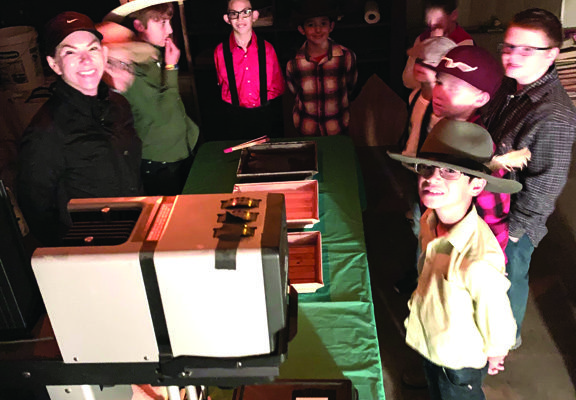Dobby Lee had several goals when he established the Frontier Town. He wanted to recreate the town of his childhood. He had extensive antique collections to preserve and display. But mostly, Dobby was interested in history and education.
Several schools with students of all ages visit Dobby’s Frontier Town to learn more about a bygone era. If their teachers are familiar with the Town, they may conduct their own tours. Sometimes small groups are led through buildings, learning the highlights and hearing a few of the stories that go with each.
For more than thirty years Alliance fourth graders have visited Dobby’s Frontier Town on a field trip as they are learning more about Nebraska history. They dress in pioneer clothing, bring their lunches in buckets, and hop on the bus. They’ll spend the day in a community with no electricity, no heat or air conditioning, and no flushing toilets. Groups of about fifteen move through different stations in the Town, where volunteers share stories about life 100 years ago.
In the German Evangelical Immanuel Lutheran Church students hear about the history of the church, built in Alliance in 1912. What else happened in 1912? Life Savers were invented – peppermint flavor only. Bubble gum was invented. It was originally called Flibber Flubber, but later renamed the Double Bubble. Churches in pioneer towns also served as schools and meeting halls.
A quick tour of the west town means kids visit the saloon, hear about blacksmiths, look at the forms used to create shoes in the cobbler shop, see trays of teeth in the dental office, medical equipment in the doctor’s office, view coffins in the funeral parlor. If they get too mouthy, they better be careful they don’t get locked in the jail!
Students sit in old wooden desks in the schoolhouse. They’ll get a few lessons the way they might have been taught decades ago. A highlight is learning to play some of the games their great grandparents might have enjoyed – things like jacks or pick-up sticks.
The chuckwagon is where students learn about the cattle drives of the late 1800’s. A good cook was highly prized. The chuckwagon stored bedrolls and personal items of the cowhands. Chuckwagon food typically consisted of dried beans, coffee, dried apples, flour and sourdough starter for biscuits, and meat that was salted, dried, or smoked. A water barrel was attached to the wagon and canvas was hung underneath to carry firewood or, more likely, cow pies.
Students then move to the two homes in the northwest corner of Dobby’s Frontier Town. The crude cabin was built by the first Black homesteader in Nebraska. Robert Anderson was born a slave, enlisted in the Union Army, and finally settled near Hemingford. By 1900 he was a prosperous landowner. The hay bale house is similar to many built in the Sandhills where sod and lumber were not available. Students compare the two homes and their furnishings, representing times that were about thirty years apart.
The highlight of the field trip is in the main house. The crew from Steph’s Studio work with the fourth graders to create photograms. Students are given trays with special paper and a variety of small objects they can arrange. Half the group takes their finished trays to the garage, which has been converted to a dark room. Kids can see their artistic creations gradually appear as white shapes on a black background as their trays are exposed to chemicals. The other half learns about the history of photography. They’ll see the first photos taken in the early 1800’s, early motion pictures using a zoetrope, and early color photos, all preceding the digital photography used today. They also get to look through stereoscopes, those early 3-D images our grandparents enjoyed, before they trade places and head to the dark room.
Remember that Dobby’s is funded by donations and relies on volunteers for special events, tours, and maintenance. Dobby’s Frontier Town closes for the season on October 1 every year, reopening May 1. Therefore, this will be the last column about the buildings and special artifacts until May, 2022.

